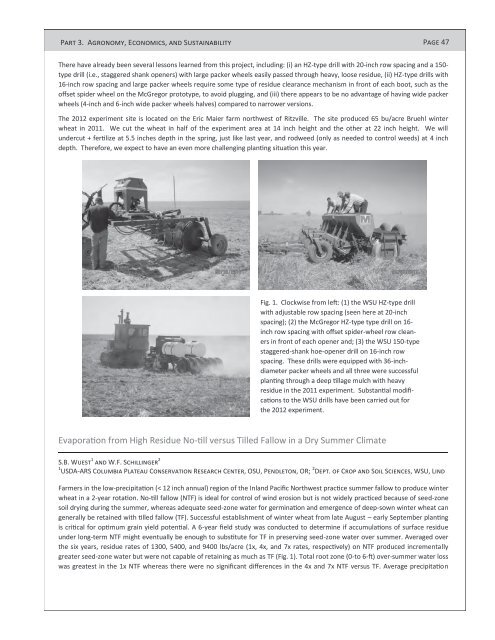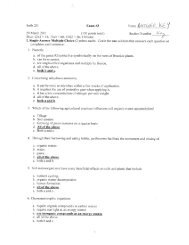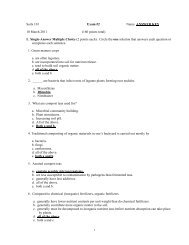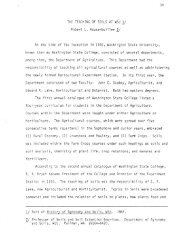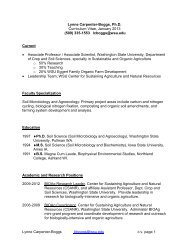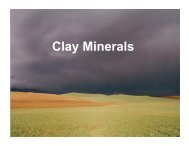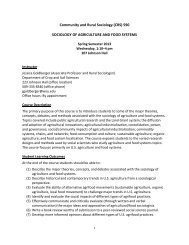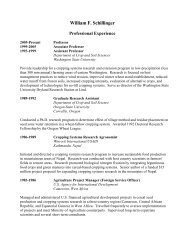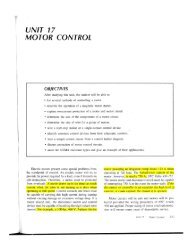2012 Dryland Field Day Abstracts - Dept. of Crop and Soil Sciences ...
2012 Dryland Field Day Abstracts - Dept. of Crop and Soil Sciences ...
2012 Dryland Field Day Abstracts - Dept. of Crop and Soil Sciences ...
You also want an ePaper? Increase the reach of your titles
YUMPU automatically turns print PDFs into web optimized ePapers that Google loves.
Part 3. Agronomy, Economics, <strong>and</strong> Sustainability Page 47<br />
There have already been several lessons learned from this project, including: (i) an HZ-type drill with 20-inch row spacing <strong>and</strong> a 150type<br />
drill (i.e., staggered shank openers) with large packer wheels easily passed through heavy, loose residue, (ii) HZ-type drills with<br />
16-inch row spacing <strong>and</strong> large packer wheels require some type <strong>of</strong> residue clearance mechanism in front <strong>of</strong> each boot, such as the<br />
<strong>of</strong>fset spider wheel on the McGregor prototype, to avoid plugging, <strong>and</strong> (iii) there appears to be no advantage <strong>of</strong> having wide packer<br />
wheels (4-inch <strong>and</strong> 6-inch wide packer wheels halves) compared to narrower versions.<br />
The <strong>2012</strong> experiment site is located on the Eric Maier farm northwest <strong>of</strong> Ritzville. The site produced 65 bu/acre Bruehl winter<br />
wheat in 2011. We cut the wheat in half <strong>of</strong> the experiment area at 14 inch height <strong>and</strong> the other at 22 inch height. We will<br />
undercut + fertilize at 5.5 inches depth in the spring, just like last year, <strong>and</strong> rodweed (only as needed to control weeds) at 4 inch<br />
depth. Therefore, we expect to have an even more challenging planting situation this year.<br />
Fig. 1. Clockwise from left: (1) the WSU HZ-type drill<br />
with adjustable row spacing (seen here at 20-inch<br />
spacing); (2) the McGregor HZ-type type drill on 16inch<br />
row spacing with <strong>of</strong>fset spider-wheel row cleaners<br />
in front <strong>of</strong> each opener <strong>and</strong>; (3) the WSU 150-type<br />
staggered-shank hoe-opener drill on 16-inch row<br />
spacing. These drills were equipped with 36-inchdiameter<br />
packer wheels <strong>and</strong> all three were successful<br />
planting through a deep tillage mulch with heavy<br />
residue in the 2011 experiment. Substantial modifications<br />
to the WSU drills have been carried out for<br />
the <strong>2012</strong> experiment.<br />
Evaporation from High Residue No-till versus Tilled Fallow in a Dry Summer Climate<br />
S.B. Wuest 1 <strong>and</strong> W.F. Schillinger 2<br />
1 USDA-ARS Columbia Plateau Conservation Research Center, OSU, Pendleton, OR; 2 <strong>Dept</strong>. <strong>of</strong> <strong>Crop</strong> <strong>and</strong> <strong>Soil</strong> <strong>Sciences</strong>, WSU, Lind<br />
Farmers in the low-precipitation (< 12 inch annual) region <strong>of</strong> the Inl<strong>and</strong> Pacific Northwest practice summer fallow to produce winter<br />
wheat in a 2-year rotation. No-till fallow (NTF) is ideal for control <strong>of</strong> wind erosion but is not widely practiced because <strong>of</strong> seed-zone<br />
soil drying during the summer, whereas adequate seed-zone water for germination <strong>and</strong> emergence <strong>of</strong> deep-sown winter wheat can<br />
generally be retained with tilled fallow (TF). Successful establishment <strong>of</strong> winter wheat from late August – early September planting<br />
is critical for optimum grain yield potential. A 6-year field study was conducted to determine if accumulations <strong>of</strong> surface residue<br />
under long-term NTF might eventually be enough to substitute for TF in preserving seed-zone water over summer. Averaged over<br />
the six years, residue rates <strong>of</strong> 1300, 5400, <strong>and</strong> 9400 lbs/acre (1x, 4x, <strong>and</strong> 7x rates, respectively) on NTF produced incrementally<br />
greater seed-zone water but were not capable <strong>of</strong> retaining as much as TF (Fig. 1). Total root zone (0-to 6-ft) over-summer water loss<br />
was greatest in the 1x NTF whereas there were no significant differences in the 4x <strong>and</strong> 7x NTF versus TF. Average precipitation


